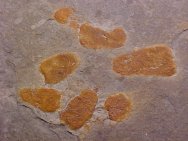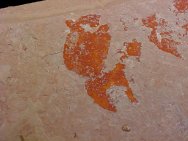Phylum Porifera - Sponge Fossils
Phylum Porifera - Sponge Fossils |
Of
related interest: |
|
|
Interestingly,
and consistent with their early evolution, the cells of sponges
are far more independent that those of other animals. Different
cell types perform distinct bodily functions that together allow
the composite organism to feed and live. Lacking mouths, special
cells form small pores that filter food from the sea as other
cells form flagella that maintain a constant flow through a series
of bodily channels. Some sponges are radially symmetrical and
others asymmetrical. Skeletal support comes from protein collagen
and spicules that are calcareous or siliceous. Reproduction by
sponges is by both sexual and asexual means. The oldest (likely) sponge in the fossil record, Paleophragmodictya, was described in 1996, coming from the Vandian or Ediacaran of Southern Australia dating to the period of 650 to 543 million years ago, the latest time of the Proterozoic. Of this period of time Darwin wrote: "The difficulty of assigning any good reason for the absence of vast piles of strata rich in fossils beneath the Cambrian system is very great ….only a small portion of the world is known with accuracy." Sponges
are represented in the fossil record since the Precambrian, and
the Phanerozoic sponges have been a critical component of reef
ecosystem. While often rare, sponge fossils from the Cambrian
Explosion are found in several Cambrian sites in North America,
most notably the Burgess Shale of Canada, and the Cambrian
strata of Utah. Sponges are also described from the Chengjiang
biota of China. The Profera are believed to have undergone
repeated radiations in the Paleozoic and Mesozoic eras, and probably
attained their greatest diversity in the Cretaceous period. |
||
Fossil
Museum Navigation:
Home Geological Time Paleobiology Geological History Tree of Life Fossil Sites Fossils Evolution Fossil Record Museum Fossils |


